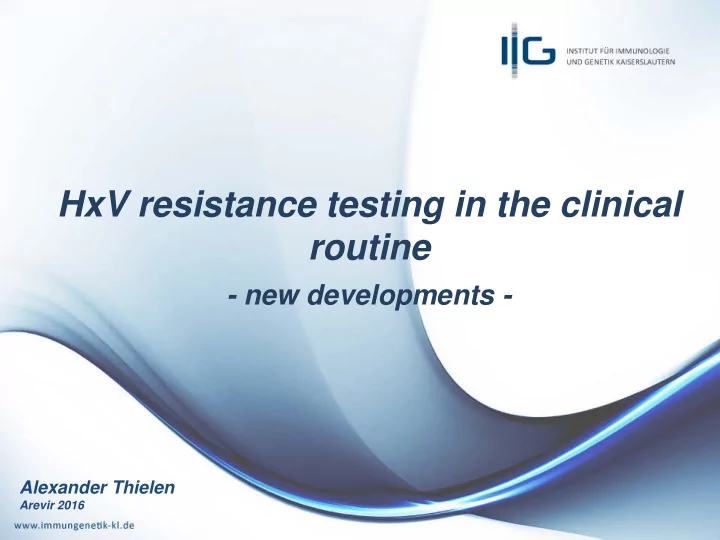

HxV resistance testing in the clinical routine - new developments - Alexander Thielen Arevir 2016
some numbers in 2015: – >3300 HIV samples (3000 PR/RT, 1800 IN, 750 ENV) • ~800 for own clinical routine • ~600 for studies – >1400 HCV samples (450 NS3, 1000 NS5): – 200 HBV samples additional targets: – HEV, HDV, JCV, RSV, CMV, ...
post-processing modules – contamination detection – database lookup – covariation analyses – reporting – Apobec filtering
contamination detection – searches for mutation patterns in data from the last 31 days – approach: • check for all amino acid mutations with ≥10% prevalence in sample A if they occur with ≥ 2% prevalence in sample B (and vice versa) A B K103N: 90% 5% M184V 80% 0.2% • if the number of differences is below a specified cutoff, then compare the sequences on nucleotide level CGAT G AAC R AG G GA CGAT R AAC Y AG A GA .... . ... X .. X .. – provides also information on used barcodes
database lookup
Covariation analysis
reporting
Apobec filter – amount of samples with low viral loads increasing – desire to switch under successful therapy – problem: Apobec 3F/3G mutations (G to A) in DNA, what is really there? – approach: naïve Bayes classifiers (related to Reuman et al., 2010)
Apobec filter – trained on >100mio reads – tested on 523 samples (111 DNA, 412 RNA) hypermutated 5% 10% 15% 20% 30% reads DNA 19.82% 12.61% 11.71% 9.01% 4.50% RNA 15.05% 5.58% 1.46% 0.73% 0.00% – minor problems with subtypes A and C – integrase still in evaluation
deep type HIV (version 2.0) – implemented in java – faster, especially for samples with several targets – better procedures for noise reduction – additional information and features – validated on 618 samples from the routine • comparison of amino acid frequencies (positions with coverage >1000
Apobec filter (example)
Apobec filter (example) 16-22995D 16-22995D 16-22995D (v1) (v1) (v1) (v2) (v2) (filtered) PR-K20I PR-K20I PR-K20I 99.2% 99.2% 99.2% 11.69% 0.01% PR-G73R PR-G73R PR-G73R 11.1% 11.1% 11.1% 11.69% 11.73% 0.65% PR-T74A PR-T74A PR-T74A 10.9% 10.9% 10.9% 11.73% PR-V82I PR-V82I PR-V82I 99.5% 99.5% 99.5% PR-L89M PR-L89M PR-L89M 99.5% 99.5% 99.5% RT-V90I RT-V90I RT-V90I 99.1% 99.1% 99.1% RT-A98S RT-A98S RT-A98S 99.6% 99.6% 99.6% 8.86% 8.52% RT-M184I RT-M184I RT-M184I 10.2% 10.2% 10.2% 8.86% IN-G140R IN-G140R IN-G140R 18.8% 18.8% 18.8% IN-E157K IN-E157K IN-E157K 2.6% 2.6% 2.6% IN-G163R IN-G163R IN-G163R 15.9% 15.9% 15.9%
Apobec filter (example)
Acknowledgments Kirsten Becker Nina Engel Anna Memmer Bettina Spielberger Martin Däumer Bernhard Thiele
Recommend
More recommend